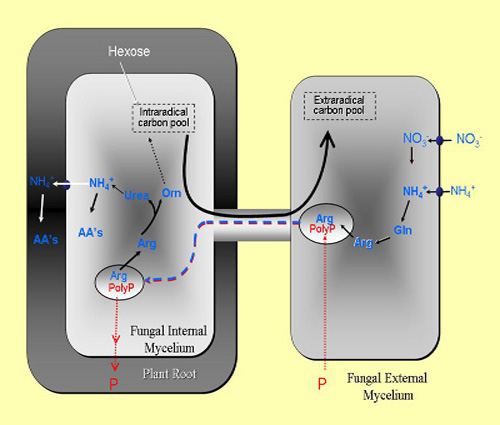Arbuscular Mycorrhizal Symbiosis

Arbuscular mycorrhizal symbiosis
Over 80% of plants obtain their mineral nutrients with the help of symbiotic fungi that grow in and around their roots. These root-fungal partnerships (mycorrhizas) are credited with assisting plants in the colonization of land over 400 million years ago; today they are found across all major taxa of plants and in ecosystems all around the world. Billions of tons of carbon flow annually from host leaves to mycorrhizas to support this relationship, which is responsible for huge nutrient uptake fluxes into plants worldwide. Despite the importance of these fluxes to plant ecology, evolution and function, we have only recently begun to describe the numerous pathways involved.

Our work has traced the routes by which carbon flows from roots to fungi and how nitrogen flows from fungi to roots. Using isotopic labeling, spectroscopic analysis, gene characterization, and expression measurements we have developed working models for carbon and nitrogen metabolism and transport (illustrated below). We are working to extend these models, which are now largely accepted, to address unanswered questions about their mechanisms and to include regulation of these fluxes under various environmental and nutrient-limitation conditions.
The movement of Nitrogen in the AM symbiosis
 Based on previous work we proposed the scheme shown to the left by which nitrogen
moves from soil to plant via arbuscular mycorrhizal fungi (Bago et al 2001). We subsequently
provided evidence from labeling and gene expression that this is how N moves through the symbiosis (Govindarajulu et al 2005; Jin et al 2005). Inorganic N (NO3– and NH4+) is taken up by the external mycelium, assimilated and converted to arginine, which
is transported (probably in association with Polyphosphate) within the fungus to the
fungal mycelium inside plant roots. There the arginine is broken down to release ammonium
which is transferred to the plant without carbon. More recently we have identified
most of the fungal metabolic genes involved in N movement and begun to characterize
the regulation of the pathway.
Based on previous work we proposed the scheme shown to the left by which nitrogen
moves from soil to plant via arbuscular mycorrhizal fungi (Bago et al 2001). We subsequently
provided evidence from labeling and gene expression that this is how N moves through the symbiosis (Govindarajulu et al 2005; Jin et al 2005). Inorganic N (NO3– and NH4+) is taken up by the external mycelium, assimilated and converted to arginine, which
is transported (probably in association with Polyphosphate) within the fungus to the
fungal mycelium inside plant roots. There the arginine is broken down to release ammonium
which is transferred to the plant without carbon. More recently we have identified
most of the fungal metabolic genes involved in N movement and begun to characterize
the regulation of the pathway.